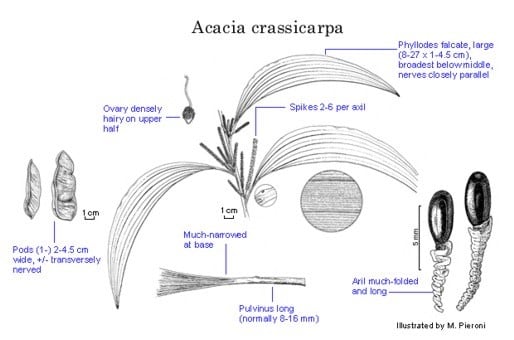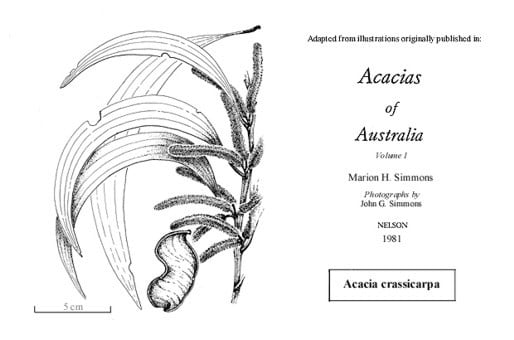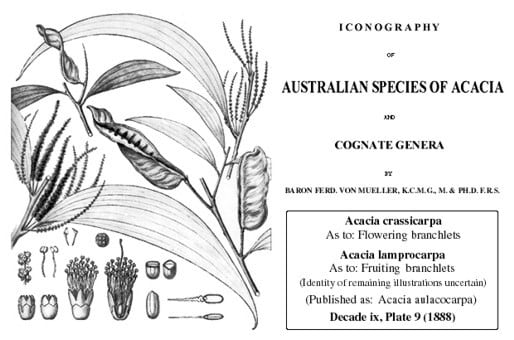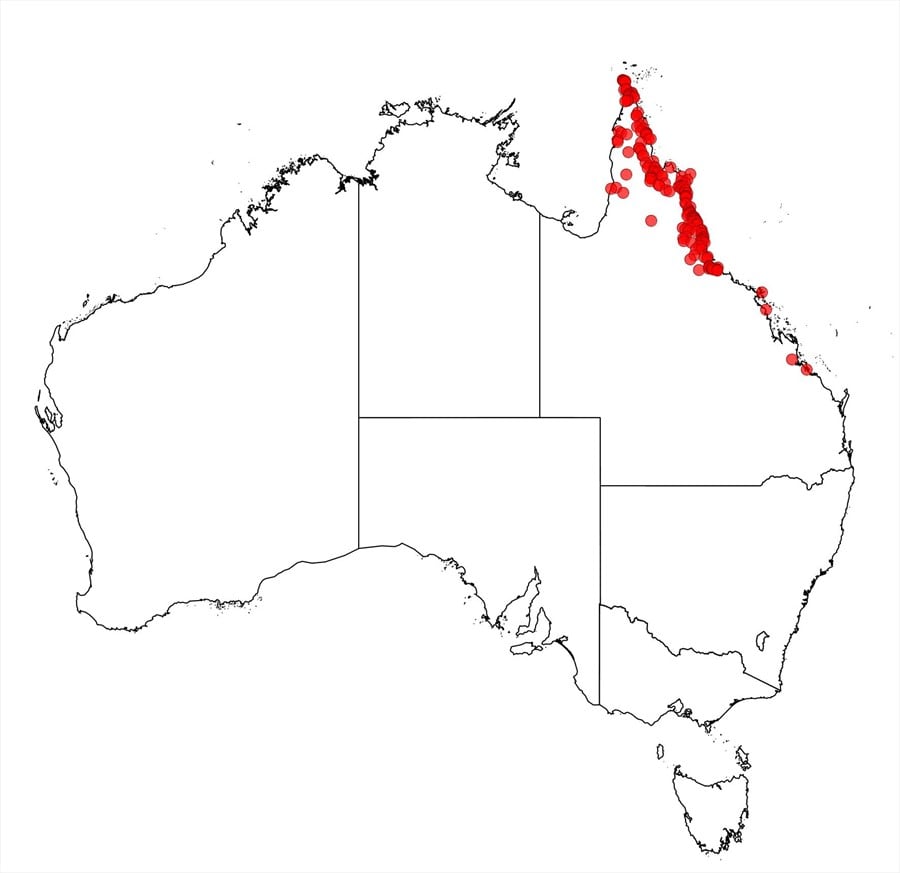Acacia crassicarpa A.Cunn. ex Benth.
WATTLE
Acacias of Australia
Common Name
Thick-podded Salwood, Northern Wattle
Family
Fabaceae
Distribution
Occurs in tropical Qld, from islands of the Torres Strait through Cape York Penin. to Townsville, with southern outliers at the Burdekin R., Whitsunday Is and near Mackay. Planted, but seemingly not naturalized, on Melville Is., N.T.
Description
Tree 6–25 (–30) m high, canopy grey green. Bark deeply rimose. Branchlets slightly angular towards apices, glabrous. Phyllodes lanceolate, attenuated at both ends, falcate or subfalcate, 8–27 cm long, (7–) 10–45 mm wide, coriaceous or thinly coriaceous, pale green to grey green, glabrous; longitudinal nerves numerous (4–6 per mm), parallel and not anastomosing, 3 main nerves raised (when dry), broader and more prominent than the rest, 3 or 4 less prominent secondary nerves also present, the minor nerves not or scarcely raised, lowermost main nerves commonly confluent with lower margin for a short distance above pulvinus; pulvinus (5–) 8–16 mm long. Inflorescences simple, 2–6 per axil; peduncles 3–10 mm long, glabrous; spikes (2–) 3–7 cm long, pale yellow to light golden. Flowers 5-merous; calyx gamosepalous, shallowly dissected, glabrous; ovary densely hairy on upper half. Pods oblong to narrowly oblong, flat, sometimes spirally once twisted, ±straight, (3–) 4–12 cm long, (1–) 2–4.5 cm wide including wing, woody, resinous, glabrous, dehiscing along ventral suture, with ±transverse, numerous, crowded, rather fine nerves. Seeds transverse, oblong to ovate, 5–6 mm long, black; aril 5–20 mm long.
Phenology
Flowers April–June.
Habitat
Grows in Acacia or Eucalyptus woodlands and open forest in sandy or rocky soil or in coastal scrub on sand dunes. Also occurs from SE Irian Jaya, Indonesia, E to Papua New Guinea, fide M.W.McDonald & B.R.Maslin, Austral. Syst. Bot. 13: 41 (2000).
Specimens
Qld: Somerset, D.H.Benson 554 (NSW); 64 km by road SSE of Ingham, R.G.Coveny 6936 & P.Hind (A, AD, BRI, CANB, K, L, PERTH, US); Slade Point Nat. Res., M.W.McDonald & B.R.Maslin BRM 7623 (BRI, CANB, DNA, K, NSW, PERTH); Jardine R., C.H.Gittins 1842 (NSW); 20 miles [32 km] N of Townsville, 30 May 1967, J.T.Waterhouse (K, MEL, NSW).
Notes
A variable species with respect to habit and the size of phyllodes and pods, see M.W.McDonald & B.R.Maslin, op cit. 44, for discussion.
A member of the ‘A. aulacocarpa group’, most closely related to A. lamprocarpa, A. midgleyi and A. peregrinalis (from New Guinea). It is distinguished from these and other species of the group by a combination of the following characters: large trees with trunks not fluted and bark deeply rimose, phyllodes large, lanceolate, falcate and much narrowed at base, pulvinus long, spikes light golden to pale yellow and often numerous within phyllode axils, pods broad and finely transversely nerved, and aril long. Acacia crassicarpa putatively hybridizes with A. aulacocarpa at Bluewater Ck near Townsville, Qld (M.W.McDonald & B.R.Maslin BRM 7630, BRI, NSW, PERTH) and with A. midgleyi at the northern tip of Cape York Pen. (R.J.Cumming 8087, CANB); see M.W.McDonald & B.R.Maslin, op cit. 44–45, for further discussion.
Details of ecology, utilisation, etc. of A. crassicarpa are given in J.W.Turnbull (ed.), Multipurpose Austral. Trees & Shrubs 128 (1986).
The treatment of A. crassicarpa by NSW, Fl. Australia 11B: 168 (2001) is modified here in accordance with the revision of the species by M.W.McDonald & B.R.Maslin, op. cit. 39–45.
FOA Reference
Data derived from Flora of Australia Volumes 11A (2001), 11B (2001) and 12 (1998), products of ABRS, ©Commonwealth of Australia
Author
Revised by B.R.Maslin
Dr M.D.Tindale and Dr P.G.Kodela with the assistance of M.Bedward, S.J.Davies, C.Herscovitch, D.A.Keith and/or D.A.Morrison
This identification key and fact sheets are available as a mobile application:
URL: https://apps.lucidcentral.org/wattle/
© Copyright 2018. All rights reserved.











